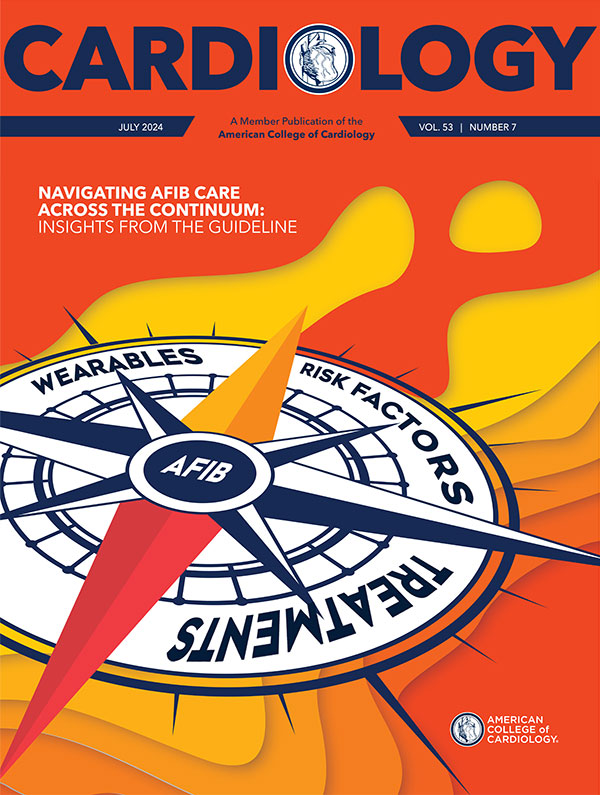Quality Improvement For Institutions | Enhancing Practice and Patient Outcomes With NCDR’s Real-World Data

ACC's NCDR suite of registries is a robust source of data for researchers, and a critical component in continuing to help hospitals, practices and clinicians advance the quality of cardiovascular care and improve patient outcomes for all.
The real-world evidence from recent NCDR research provides insights related to the operator's career stage and outcomes from PCI, as well as transcatheter mitral valve-in-ring (MViR) as an alternative approach for patients with high surgical risk.
Other studies leveraging NCDR data have shown that the fifth-generation SAPIEN 3 Ultra Resilia valve, compared with earlier generation SAPIEN valves, lowers mean gradients and paravalvular leak (PVL), and substantial site-level variation in permanent pacemaker implantation (PPI) persists.
Read on and then share your thoughts about the findings using #NCDR and #CardiologyMag or join in discussions on the ACC's LinkedIn page.
Does Operator Career Status Impact PCI Outcomes?
Early-career interventional cardiologists are performing PCI procedures on patients with more acute presentations and higher predicted risk of mortality and bleeding than their more experienced counterparts, and these are associated with modestly worse outcomes, according to a study published in JACC.
ACC Quality Summit 2024: Save the Date!
Plan now to be in San Antonio, TX, from Sept. 17 to 19, for this year's Quality Summit. Click here to learn more.
Jennifer A. Rymer, MD, MBA, MHS, et al., used data from ACC's CathPCI Registry to conduct an operator-level analysis of patients undergoing PCI between April 2018 and June 2022. They examined annual case volume, expected mortality and bleeding risk, and observed/predicted mortality and bleeding outcomes, and included 1,451 early-career operators – within five years of the end of their training – and 6,251 non–early-career operators, with 1,011 operators changing their career status over the course of the study period. In total, 514,540 patients were treated by early-career operators and 2,296,576 patients by non–early-career operators.
Results showed that median annual case volume per operator was 59 (Q1-Q3: 31-97) for early-career operators vs. 57 (Q1-Q3: 28-100) for non–early-career operators. Early-career operators were more likely to perform PCI on patients presenting with STEMI and urgent indications for the procedure (both p<0.001).
When comparing early-career vs. non–early-career operator groups, median predicted mortality risk was 2.0% vs. 1.8% and median predicted bleeding risk was 4.9% vs. 4.4%. Early-career operators were also associated with an increased risk of mortality (odds ratio [OR], 1.08; 95% CI, 1.05-1.17; p<0.0001) and bleeding (OR, 1.08; 95% CI, 1.05-1.12; p<0.0001) after adjustment.
"It would theoretically be beneficial for early-career operators to treat a lower-risk population while they develop their independent practice and hone skills, but our study found that the opposite occurs," write the authors. "Early-career operators may be expected to carry a higher call burden during their early years in practice and are therefore performing a higher ratio of urgent/elective PCIs. It is also possible that early-career operators have more risk-tolerant case selection or are presented with high-risk cases by colleagues."
Transcatheter MViR and Patients With High Surgical Risk
Transcatheter MViR using third-generation balloon-expandable aortic transcatheter heart valves was associated with a significant reduction in mitral regurgitation (MR) and improvement in heart failure symptoms at one year, with the tradeoff of elevated valvular gradients and a high rate of reintervention, according to a study published in JACC: Cardiovascular Interventions.
Mayra E. Guerrero, MD, FACC, et al., analyzed data from the STS/ACC TVT Registry, including 820 patients (mean age 72.2 years, 50.9% women, mean STS score 8.2%, 78% NYHA functional class III to IV) from 236 sites who underwent MViR between August 2015 and December 2022. They had a mean left ventricular ejection fraction of 47.8% ± 14.2%, a mean mitral gradient of 8.9 ± 7.0 mm Hg, and 75.5% of patients had ≥moderate MR.
Transseptal access was used in 93.9% of cases, and technical success was observed in 88% of cases. At 30-days post procedure, all-cause mortality was 8.3%.
At one year, investigators found all-cause mortality increased to 22.4% and the reintervention rate was 9.1%. When evaluating symptom severity and quality of life, they noted 75.6% of patients were NYHA functional class I to II, Kansas City Cardiomyopathy Questionnaire scores increased by 25.9 ± 29.1 points, mean mitral valve gradient was 8.4 ± 3.4 mm Hg and 91.7% of patients had ≤mild MR.
"Transcatheter MViR is a reasonable alternative for high or extreme surgical risk patients who are unable to undergo surgery and have appropriate anatomy for the procedure," write the authors. "Careful patient selection is essential to avoid procedure complications and poor outcomes."
Outcomes With Fifth-Generation Balloon Expandable THV
The fifth-generation SAPIEN 3 Ultra Resilia valve (S3UR) transcatheter heart valve (THV), used in TAVR procedures, is associated with lower mean gradients and lower rates of PVL when compared to outcomes with the SAPIEN 3 (S3) and SAPIEN 3 Ultra (S3U) valves, according to a study presented at CRT 2024 and simultaneously published in JACC: Cardiovascular Interventions.
NCDR On the Road
Abstracts featuring data from NCDR's family of registries were presented at recent meetings. Click here to read abstracts presented at SCAI 2024.
Click here to read abstracts presented at Heart Rhythm 2024.
Curtiss T. Stinis, MD, FACC, et al., used STS/ACC TVT Registry data from Jan. 1, 2021 to June 30, 2023, to compare procedural, in-hospital and 30-day outcomes of the S3UR valve vs. the earlier S3U and S3 models. They included 10,314 S3UR patients who were propensity matched with 10,314 patients selected from a pool of 150,539 S3U or S3 patients captured by the registry.
Results showed no statistically significant differences in death, stroke or bleeding between the groups at 30-days post procedure; however, there was a higher hospital readmission rate among S3UR patients (8.5% vs. 7.7%; p=0.04).
At discharge, patients who received the S3UR valve, vs. the S3U or S3 valve, had significantly lower mean gradients (9.2 mm Hg) and larger aortic valve area (2.1 cm2).
"The present study demonstrates a significant reduction in PVL for the 29-mm S3UR valve size in comparison to the previous generation 29-mm S3 valve, which is undoubtably due to the incorporation of the Ultra sealing skirt design," write the authors. "Importantly, this reduction in PVL was accomplished without any obvious tradeoffs with respect to hemodynamic performance, permanent pacemaker rates, or other procedural complications in this real-world population."
Substantial Site-Level Variation in PPI Rates Post TAVR
Despite decreasing rates of PPI after TAVR, substantial site-level variation persists, suggesting the need for quality improvement initiatives like replicating best practices from high-performing sites and increased guideline-based education, according to a study published in JACC: Cardiovascular Interventions.
NCDR: Data Powering Performance
More than 2,000 facilities worldwide participate in one or more the ACC's registries, forming a comprehensive network of cardiovascular care providers committed to ensuring evidence-based cardiovascular care, improving patient outcomes and lowering health care costs.
Click here to learn more about all the NCDR registries and become a participant.
Click here and bookmark the registry news page to keep up with the clinical insights from NCDR research.

Using data captured by the STS/ACC TVT Registry, Amit N. Vora, MD, MPH, FACC, et al., included 184,452 TAVR procedures across 653 sites from 2016 to 2020, looking to investigate site-level variation and temporal trends of in-hospital and 30-day PPI after TAVR.
The overall rate of PPI was 11.3% and trended downward over time. Patients who underwent PPI were older and more likely to be male, have diabetes, prior atrial fibrillation, prior conduction defects, or higher STS Predicted Risk of Mortality scores than those who did not (p<0.001 for all).
Wide variation was noted across sites with the PPI rate ranging from 0%-36.4%. After adjusting for annualized volume, the authors identified 34 sites with PPI rates above the 95th percentile confidence interval (CI), 28 sites with rates below and wide variation among the remaining sites.
Even after accounting for patient-level factors, site variation in the probability of PPI persisted (median odds ratio, 1.39; 95% CI, 1.35-1.43; p<0.001). While some variation was explained by the addition of valve type, residual variation remained prevalent in additional models incorporating site-level covariates like annualized volume, region, teaching status and hospital beds. The study's analysis did not reveal specific site-level indicators of higher rates of PPI.
"Our study highlights the importance of collecting more granular procedure-specific data, specifically with respect to accurate implantation depth, to develop more accurate risk-prediction models," state the authors. "Additionally, more granular data collection with respect to the precise indication for [PPI] may be helpful to characterize why [PPI] is occurring."
In an accompanying editorial comment, François Philippon, MD, agrees that "the [PPI] rate post-TAVR should be a performance metric and that the value of these prospective registries could be improved by adding more granular data on conduction disturbances, [electrocardiogram] analysis, and [permanent pacemaker] interrogation over time."
Clinical Topics: Cardiac Surgery, Cardiovascular Care Team, Heart Failure and Cardiomyopathies, Invasive Cardiovascular Angiography and Intervention, Cardiac Surgery and Heart Failure, Acute Heart Failure
Keywords: Cardiology Magazine, ACC Publications, Quality Improvement, Mitral Valve, Heart Failure, Transcatheter Aortic Valve Replacement, Cardiomyopathies, Registries
